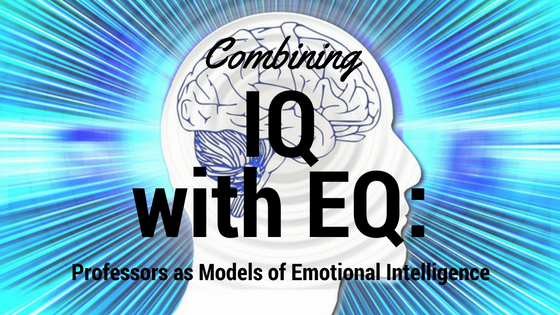
Of all soft skills, emotional intelligence is perhaps the newest in the realm of study and has been largely disregarded in academia. Emotional intelligence is comprised of self-awareness, management of emotion, and self-motivation that requires the active ability to intrinsically monitor oneself in times of difficulty (Myers & Tucker, 2005). The overall perhaps due to the assumption that being “emotionally intelligent” appears to be effortless, as we have been the guardians of our emotion for our entire lives. The result of this underestimation is a void in the workplace: many employers are reporting that students are unprepared for demands of the workplace environment. As a professor, you can reinforce principles of emotional intelligence to help improve the likelihood of your students’ future success while simultaneously creating a positive work environment for yourself.
The correlation between workplace success and a worker’s level of emotional intelligence necessitates a newfound focus on emotional skills. Laura Wilcox, the director of management programs of Harvard University, summarizes these key findings in her article “Emotional Intelligence is No Soft Skill.” As Wilcox points out, once you begin playing on the field of professionalism, you rank rather similarly in technical (“hard skills”) skills and IQ levels. Therefore, almost 90% of “what moves people up the ladder” relies on emotional intelligence (as seen in “What Makes a Leader” in the Harvard Business Review, January 2004). The inherent interconnectedness of a workplace environment creates common stressors that possess the capacity to paralyze our productivity, which Wilcox calls emotional hijacking. “With the slightest provocation, our ability to apply reason and logic can drop by 75%. Thus, instead of handling twenty-four interrelationships, we may suddenly be able to cope with only two. We may start to see only in black and white, in binary frameworks like yes or no, right or wrong, and win or lose.” As academic leaders, you can help prevent and encourage our students to work through emotional paralysis and avoid such emotional hijacking.
However, is emotional intelligence something that can be taught? According to a study by cognitive scientist Delphine Nelis, students that attended training sessions that focused on recognizing and reflecting on emotional responses were able to learn and improve upon their emotional intelligence (as cited in “Can Emotional Intelligence Be Taught?”, Goldsmith, 2009). If you are incapable of committing time to formal training sessions, Kelly Cherwin of HigherEdJobs points out that emotional intelligence is a skill that, through careful consideration of your own behavior, you can model in your classroom as a way for students to learn. In her article “Using Emotional Intelligence to Teach,” Cherwin posits that you can facilitate emotional intelligence learning by:
Creating an environment of respect, or creating an environment built on mutual reciprocity and empathy to your students’ idiosyncratic situations.
Manage your own emotions while taking responsibility. Avoid blaming your students for gaps in the learning process and work patiently with them to mitigate frustration.
Be honest and own up to your own mistakes, whether that is for your own tardiness or for gaps in your knowledge. Acknowledge these moments and show students how to move on from them.
Validate students. Cherwin gives the example that: “If a student says that they are so tired of doing hours of tedious homework every night, you could say, “I know you are feeling tired because the problems assigned do take a lot of energy to solve and I appreciate the hard work you are putting into the class. Why do you think it is necessary that we go over these types of problems?”
Improving upon your own emotional intelligence necessarily benefits your relationship with your students and their capacity to hone their own emotional intelligence.
Developing an emotional intelligence is pertinent for the career goals of student and professor alike. Current trends in the job market report an overall gap in young workers’ emotional intelligence, thus halting their flexibility in workplace performance. As professors, teaching emotional intelligence through modeling reinforces your emotional intelligence abilities while helping your students develop their own. By making your classroom environment one that promotes maturity, trust, and honesty, you have the unlimited capacity to help your students and your classroom environment.

